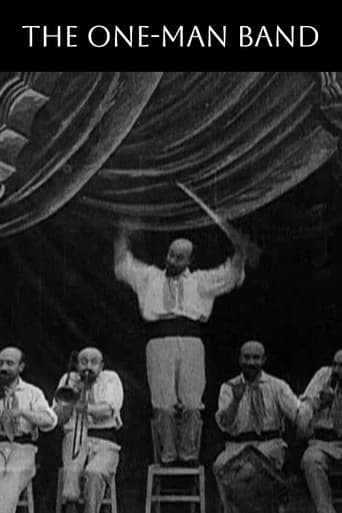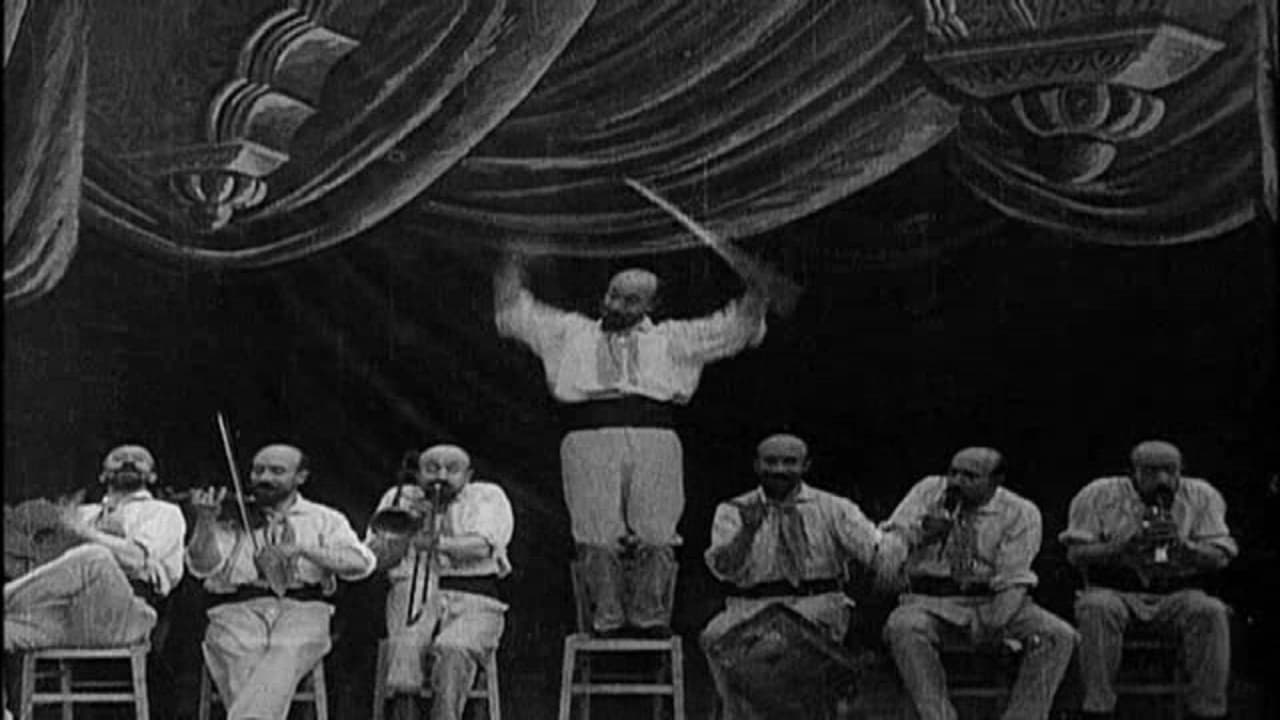CitizenCaine
In The One-Man Band, Georges Melies uses multiple exposure photography to show himself as several band members playing different instruments in unison. Melies also continues to use jump-cut editing to make objects appear and disappear (the chairs in this case) and advance the action. The work it must have taken Melies to synchronize the footage must have been extraordinary. Just as Melies makes the likenesses of himself as band members appear, he makes them disappear also echoing the many other previous films he's done with creating a scenario and then dismantling it in the context of a sole creator/creative force. *** of 4 stars.
wes-connors
French magician and filmmaker Georges Melies has seven chairs lined up across your movie screen. He appears dressed as a musician and takes a seat, then a super-imposed Mr. Melies rises, with cymbals, from the first sitting Melies and sits in the second seat. From the second seat, a drumming Melies moves on to the next seat. This goes on until all seven seats are filled with different members of an instrumental orchestra. Melies plays each part. They perform enthusiastically for the audience and meld back into the original Melies. He is a one man band!****** L'homme orchestre (1900) Georges Melies ~ Georges Melies
Michael_Elliott
One-Man Band, The (1900) *** (out of 4) aka L'Homme orchestre This here is one of director Melies best known and loved films. Melies plays a band leader and we see his spirits or doubles, come to life and make for an entire band. Buster Keaton would somewhat redo this film two decades later in The Play House and in my opinion it can't hold a candle to this film. The special effects hold up quite well and the way the spirits come to be is nicely done. Melies was certainly a genius and this is one of the highlights of his career.
José Luis Rivera Mendoza (jluis1984)
At the turn of the century, Georges Méliès' amazing shorts were the most famous motion pictures of the world, as his highly creative and technically innovative "Cinemagic" had proved that cinema was not only a quite useful device for scientific purposes, but also a very promising new way of entertainment. Méliès' most famous works are without a doubt the fantasy movies he made in the first decade of the 20th century, where he used all his special effects tricks to narrate stories of magic, horror and science fiction as the first director of fiction movies in history (1902's "Le Voyage Dans la lune" is an icon of cinema history). However, his earlier films, a collection of shorts where a magician makes impossible tricks, are as amazing as his stories, as it was in those early shorts where he polished his technique and singlehandedly invented the art of special effects.1900's short film "L' Homme Orchestre" (Known in English as "The One-Man Band") is one of those movies that would set the basis for what would become his trademark "Cinemagic" in the years to come. In this short film, the magician (as usual, played by Méliès himself) prepares for his next trick by putting seven chairs for the members of his band even when there is no sign of anyone else in the place. Suddenly, the magician sits in one of the chairs, and after he rises, a cymbal player appears sit on the chair the magician used to be. The magician moves to the next chair and repeats the trick, appearing another band member in the process, and he continues doing the same until the six chairs are occupied by a member of his orchestra. The magician has successfully replicated himself six times in order to play a song like truly a "One-Man Band".True to his theatrical style and his training as a magician, in "L' Homme Orchestre" director Georges Méliès conceived a charming and very funny way to show off a camera trick he had discovered a few years before and was truly mastering by this stage: multiple exposures. Mixing this quite interesting property of film with his great skill at editing, Georges Méliès crafted an effect that flows seamlessly and in a very fluid way. However, the movie is more than a camera trick, as the funny way that Méliès uses to set his film (making good use of pantomime) enhances the atmosphere and overall makes for a better experience. While Méliès made the multiple exposures trick very popular, and soon most of the early pioneers began to use it in their films too, it was his care for the building of the story what made his films feel different, more like a complete show and less like a mere "gimmick film".By 1900, Méliès' films had already started to be studied and imitated by many other pioneers, who followed the path traced by the "Cinemagician" in the discovery and development of the mysteries of the new art. While people like Edwin S. Porter and Ferdinand Zecca had quickly mastered the tricks that Méliès discovered (even imitating his style and plots), Méliès' were still superior in both technical achievement and artistic conception. In the following years Méliès would continue the development of this and many other effects, and his efforts would be crowned with the release of his fantasy films, where he exploited his tools to bring fairy tales to screen. "L' Homme Orchestre" is probably not one of Méliès' best known films, but it's historical importance and beautiful craftsmanship makes it a joy to watch even today, more than 100 years after its release. 7/10


 AD
AD
